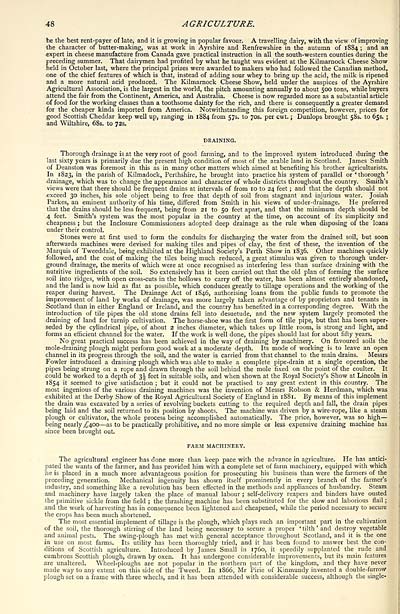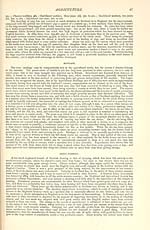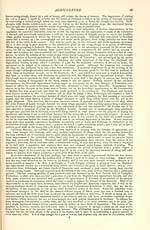Ordnance gazetteer of Scotland > Volume 6
(376) Page 48
Download files
Complete book:
Individual page:
Thumbnail gallery: Grid view | List view

48 AGRICULTURE.
be the best rent-payer of late, and it is growing in popular favour. A travelling dairy, with the view of improving
the character of butter-making, was at work in Ayrshire and Renfrewshire in the autumn of 1884 ; and an
expert in cheese manufacture from Canada gave practical instruction in all the south-western counties during the
preceding summer. That dairymen had profited by what he taught was evident at the Kilmarnock Cheese Show
held in October last, where the principal prizes were awarded to makers who had followed the Canadian method,
one of the chief features of which is that, instead of adding sour whey to bring up the acid, the milk is ripened
and a more natural acid produced. The Kilmarnock Cheese Show, held under the auspices of the Ayrshire
Agricultural Association, is the largest in the world, the pitch amounting annually to about 500 tons, while buyers
attend the fair from the Continent, America, and Australia. Cheese is now regarded more as a substantial article
of food for the working classes than a toothsome dainty for the rich, and there is consequently a greater demand
for the cheaper kinds imported from America. Notwithstanding this foreign competition, however, prices for
good Scottish Cheddar keep well up, ranging in 1884 from 57s. to 70s. per cwt. ; Dunlops brought 58s. to 65s. ;
and Wiltshire, 68s. to 72s.
DRAINING.
Thorough drainage is at the very root of good farming, and to the improved system introduced during the
last sixty years is primarily due the present high condition of most of the arable land in Scotland. James Smith
of Deanston was foremost in this as in many other matters which aimed at benefiting his brother agriculturists.
In 1823, in the parish of Kilmadock, Perthshire, he brought into practice his system of parallel or 'thorough '
drainage, which was to change the appearance and character of whole districts throughout the country. Smith's
views were that there should be frequent drains at intervals of from 10 to 24 feet ; and that the depth should not
exceed 30 inches, his sole object being to free that depth of soil from stagnant and injurious water. Josiah
Parkes, an eminent authority of his time, differed from Smith in his views of under-drainage. He preferred
that the drains should be less frequent, being from 21 to 50 feet apart, and that the minimum depth should be
4 feet. Smith's system was the most popular in the country at the time, on account of its simplicity and
cheapness ; but the Inclosure Commissioners adopted deep drainage as the rule when disposing of the loans
under their control.
Stones were at first used to form the conduits for discharging the water from the drained soil, but soon
afterwards machines were devised for making tiles and pipes of clay, the first of these, the invention of the
Marquis of Tweeddale, being exhibited at the Highland Society's Perth Show in 1836. Other machines quickly
followed, and the cost of making the tiles being much reduced, a great stimulus was given to thorough under-
ground drainage, the merits of which were at once recognised as interfering less than surface draining with the
nutritive ingredients of the soil. So extensively has it been carried out that the old plan of forming the surface
soil into ridges, with open cross-cuts in the hollows to carry off the water, has been almost entirely abandoned,
and the land is now laid as flat as possible, which conduces greatly to tillage operations and the working of the
reaper during harvest. The Drainage Act of 1846, authorising loans from the public funds to promote the
improvement of land by works of drainage, was more largely taken advantage of by proprietors and tenants in
Scotland than in either England or Ireland, and the country has benefited in a corresponding degree. With the
introduction of tile pipes the old stone drains fell into desuetude, and the new system largely promoted the
draining of land for turnip cultivation. The horse-shoe was the first form of tile pipe, but that has been super-
seded by the cylindrical pipe, of about 2 inches diameter, which takes up little room, is strong and light, and
forms an efficient channel for the water. If the work is well done, the pipes should last for about fifty years.
No great practical success has been achieved in the way of draining by machinery. On favoured soils the
mole-draining plough might perform good work at a moderate depth. Its mode of working is to leave an open
channel in its progress through the soil, and the water is carried from that channel to the main drains. Messrs
Fowler introduced a draining plough which was able to make a complete pipe-drain at a single operation, the
pipes being strung on a rope and drawn through the soil behind the mole fixed on the point of the coulter. It
could be worked to a depth of 3J feet in suitable soils, and when shown at the Royal Society's Show at Lincoln in
1854 it seemed to give satisfaction ; but it could not be practised to any great extent in this country. The
most ingenious of the various draining machines was the invention of Messrs Robson & Herdman, which was
exhibited at the Derby Show of the Royal Agricultural Society of England in 1881. By means of this implement
the drain was excavated by a series of revolving buckets cutting to the required depth and fall, the drain pipes
being laid and the soil returned to its position by shoots. The machine was driven by a wire-rope, like a steam
plough or cultivator, the whole process being accomplished automatically. The price, however, was so high —
being nearly ^400— as to be practically prohibitive, and no more simple or less expensive draining machine has
since been brought out.
FARM MACHINERY.
The agricultural engineer has done more than keep pace with the advance in agriculture. He has antici-
pated the wants of the farmer, and has provided him with a complete set of farm machinery, equipped with which
he is placed in a much more advantageous position for prosecuting his business than were the farmers of the
preceding generation. Mechanical ingenuity has shown itself prominently in every branch of the farmer's
industry, and something like a revolution has been effected in the methods and appliances of husbandry. Steam
and machinery have largely taken the place of manual labour ; self-delivery reapers and binders have ousted
the primitive sickle from the field ; the thrashing machine has been substituted for the slow and laborious flail ;
and the work of harvesting has in consequence been lightened and cheapened, while the period necessary to secure
the crops has been much shortened.
The most essential implement of tillage is the plough, which plays such an important part in the cultivation
of the soil, the thorough stirring of the land being necessary to secure a proper ' tilth ' and destroy vegetable
and animal pests. The swing-plough has met with general acceptance throughout Scotland, and it is the one
in use on most farms. Its utility has been thoroughly tried, and it has been found to answer best the con-
ditions of Scottish agriculture. Introduced by James Small in 1760, it speedily supplanted the rude and
cumbrous Scottish plough, drawn by oxen. It has undergone considerable improvements, but its main features
are unaltered. Wheel-ploughs are not popular in the northern part of the kingdom, and they have never
made way to any extent on this side of the Tweed. In 1866, Mr Pirie of Kinmundy invented a double-furrow
plough set on a frame with three wheels, and it has been attended with considerable success, although the single-
be the best rent-payer of late, and it is growing in popular favour. A travelling dairy, with the view of improving
the character of butter-making, was at work in Ayrshire and Renfrewshire in the autumn of 1884 ; and an
expert in cheese manufacture from Canada gave practical instruction in all the south-western counties during the
preceding summer. That dairymen had profited by what he taught was evident at the Kilmarnock Cheese Show
held in October last, where the principal prizes were awarded to makers who had followed the Canadian method,
one of the chief features of which is that, instead of adding sour whey to bring up the acid, the milk is ripened
and a more natural acid produced. The Kilmarnock Cheese Show, held under the auspices of the Ayrshire
Agricultural Association, is the largest in the world, the pitch amounting annually to about 500 tons, while buyers
attend the fair from the Continent, America, and Australia. Cheese is now regarded more as a substantial article
of food for the working classes than a toothsome dainty for the rich, and there is consequently a greater demand
for the cheaper kinds imported from America. Notwithstanding this foreign competition, however, prices for
good Scottish Cheddar keep well up, ranging in 1884 from 57s. to 70s. per cwt. ; Dunlops brought 58s. to 65s. ;
and Wiltshire, 68s. to 72s.
DRAINING.
Thorough drainage is at the very root of good farming, and to the improved system introduced during the
last sixty years is primarily due the present high condition of most of the arable land in Scotland. James Smith
of Deanston was foremost in this as in many other matters which aimed at benefiting his brother agriculturists.
In 1823, in the parish of Kilmadock, Perthshire, he brought into practice his system of parallel or 'thorough '
drainage, which was to change the appearance and character of whole districts throughout the country. Smith's
views were that there should be frequent drains at intervals of from 10 to 24 feet ; and that the depth should not
exceed 30 inches, his sole object being to free that depth of soil from stagnant and injurious water. Josiah
Parkes, an eminent authority of his time, differed from Smith in his views of under-drainage. He preferred
that the drains should be less frequent, being from 21 to 50 feet apart, and that the minimum depth should be
4 feet. Smith's system was the most popular in the country at the time, on account of its simplicity and
cheapness ; but the Inclosure Commissioners adopted deep drainage as the rule when disposing of the loans
under their control.
Stones were at first used to form the conduits for discharging the water from the drained soil, but soon
afterwards machines were devised for making tiles and pipes of clay, the first of these, the invention of the
Marquis of Tweeddale, being exhibited at the Highland Society's Perth Show in 1836. Other machines quickly
followed, and the cost of making the tiles being much reduced, a great stimulus was given to thorough under-
ground drainage, the merits of which were at once recognised as interfering less than surface draining with the
nutritive ingredients of the soil. So extensively has it been carried out that the old plan of forming the surface
soil into ridges, with open cross-cuts in the hollows to carry off the water, has been almost entirely abandoned,
and the land is now laid as flat as possible, which conduces greatly to tillage operations and the working of the
reaper during harvest. The Drainage Act of 1846, authorising loans from the public funds to promote the
improvement of land by works of drainage, was more largely taken advantage of by proprietors and tenants in
Scotland than in either England or Ireland, and the country has benefited in a corresponding degree. With the
introduction of tile pipes the old stone drains fell into desuetude, and the new system largely promoted the
draining of land for turnip cultivation. The horse-shoe was the first form of tile pipe, but that has been super-
seded by the cylindrical pipe, of about 2 inches diameter, which takes up little room, is strong and light, and
forms an efficient channel for the water. If the work is well done, the pipes should last for about fifty years.
No great practical success has been achieved in the way of draining by machinery. On favoured soils the
mole-draining plough might perform good work at a moderate depth. Its mode of working is to leave an open
channel in its progress through the soil, and the water is carried from that channel to the main drains. Messrs
Fowler introduced a draining plough which was able to make a complete pipe-drain at a single operation, the
pipes being strung on a rope and drawn through the soil behind the mole fixed on the point of the coulter. It
could be worked to a depth of 3J feet in suitable soils, and when shown at the Royal Society's Show at Lincoln in
1854 it seemed to give satisfaction ; but it could not be practised to any great extent in this country. The
most ingenious of the various draining machines was the invention of Messrs Robson & Herdman, which was
exhibited at the Derby Show of the Royal Agricultural Society of England in 1881. By means of this implement
the drain was excavated by a series of revolving buckets cutting to the required depth and fall, the drain pipes
being laid and the soil returned to its position by shoots. The machine was driven by a wire-rope, like a steam
plough or cultivator, the whole process being accomplished automatically. The price, however, was so high —
being nearly ^400— as to be practically prohibitive, and no more simple or less expensive draining machine has
since been brought out.
FARM MACHINERY.
The agricultural engineer has done more than keep pace with the advance in agriculture. He has antici-
pated the wants of the farmer, and has provided him with a complete set of farm machinery, equipped with which
he is placed in a much more advantageous position for prosecuting his business than were the farmers of the
preceding generation. Mechanical ingenuity has shown itself prominently in every branch of the farmer's
industry, and something like a revolution has been effected in the methods and appliances of husbandry. Steam
and machinery have largely taken the place of manual labour ; self-delivery reapers and binders have ousted
the primitive sickle from the field ; the thrashing machine has been substituted for the slow and laborious flail ;
and the work of harvesting has in consequence been lightened and cheapened, while the period necessary to secure
the crops has been much shortened.
The most essential implement of tillage is the plough, which plays such an important part in the cultivation
of the soil, the thorough stirring of the land being necessary to secure a proper ' tilth ' and destroy vegetable
and animal pests. The swing-plough has met with general acceptance throughout Scotland, and it is the one
in use on most farms. Its utility has been thoroughly tried, and it has been found to answer best the con-
ditions of Scottish agriculture. Introduced by James Small in 1760, it speedily supplanted the rude and
cumbrous Scottish plough, drawn by oxen. It has undergone considerable improvements, but its main features
are unaltered. Wheel-ploughs are not popular in the northern part of the kingdom, and they have never
made way to any extent on this side of the Tweed. In 1866, Mr Pirie of Kinmundy invented a double-furrow
plough set on a frame with three wheels, and it has been attended with considerable success, although the single-
Set display mode to: Large image | Transcription
Images and transcriptions on this page, including medium image downloads, may be used under the Creative Commons Attribution 4.0 International Licence unless otherwise stated. ![]()
| Gazetteers of Scotland, 1803-1901 > Ordnance gazetteer of Scotland > Volume 6 > (376) Page 48 |
|---|
| Permanent URL | https://digital.nls.uk/97392114 |
|---|
| Attribution and copyright: |
|
|---|---|

